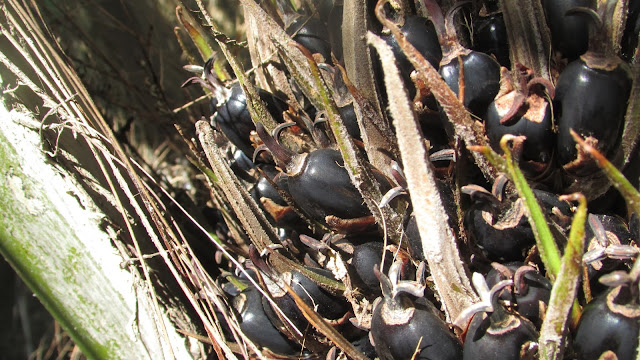Dampa: Some Questions
Have you seen Oil Palm in Tiger Reserve? And other questions on Dampa
This is the unedited version of the piece published in Deccan Herald.
Recent trips to Dampa have been followed with a series of interesting questions, by friends, on the landscape.
Dampa is often referred to as being
different from other Tiger Reserves be it management or tiger sightings? Why is
it so?
There
are multiple reasons. To begin with, Dampa is not an atypical Tiger Reserve in
the lines of Ranthambore or Corbett where one enjoys a drive a four wheel
vehicle; here one walks up and down the forest. On sightings the Indian Express during September 2015 reports ‘ Senior
forest officials in the state and conservationists who have worked there admit
there have been no tiger sightings in Dampa for decades, and no tiger has been
caught by numerous camera traps although a large assortment of other wildlife —
including smaller wild cats — has been.” Management issues include lack of
single management in the Tiger Reserve; the Tiger Conservation Plan states “The management of the buffer area is under
two territorial divisions viz. Mamit and Kawrthah.”
Why do people in fringe villages talk so
much of wildlife – human conflict in a landscape where population pressure is less
compared to other Tiger Reserves?
Wildlife-human
conflict in the landscape has had multiple shifts in recent years. From jhum (shifting cultivation) prevalent in the
landscape earlier we have people moving towards cash crops; oil palm being the
major culprit today. As a corollary, conflict which was primarily seasonal has
become a round the year phenomenon. Also, confusions exist on the compensation
mechanism for these cash crops. People have complained of compensation amount
being disproportionate to their loses, of inordinate delays in receiving the
payments and management not adhering to a uniform policy. As if the decreased
tolerance on account of high investment was not enough we have representatives
of companies, that promote oil palm, advise people to shoot wildlife which
harms the plantation!
Is hunting the biggest threat to Dampa?
Hunting
is an issue which we need to work towards but habitat loss is a far bigger
threat.
If we continue to rid the landscape of natural vegetation
like we are doing, we will-
§ In
the short run be left with a Wildlife Sanctuary which is an island amidst
‘unfriendly-to-conservation’ plantations§ In the long run fail to protect the Wildlife Sanctuary also. People from fringe villages may not have any other place to get bamboo and other forest products from.
Then
there is the water that oil palm coming up in the landscape will need! Let me
ask a question in return. Have you seen oil palm elsewhere in the country
inside a Tiger Reserve?
People talk of eco-development programs
in the past but what are the actions that one could take up in today’s
situation to conserve the biodiversity in village lands?
Eco-development
programs (eg: piggery) appear not to
have helped. There is a need to go beyond what has been going on. People could be
encouraged and enabled to grow bamboo. May sound funny to help grow bamboo in
Mizoram, often referred to as the bamboo state, but in some villages within the
Tiger Reserve people are facing acute shortages of bamboo. Bamboo, is not only
indispensable but also intricately connected to the lives of people inhabiting
the landscape; Mizos, Brus (Reangs)
or Chakmas. They need to be able to get bamboo (and other forest products) from village lands; else the Wildlife Sanctuary
is the only option. Some villages have remnant patches of natural vegetation, erstwhile
traditional reserves, and a system to incentivize these refuges of biodiversity
in village lands needs to be brought in place before we lose them.
Is the Bru repatriation a major threat to
the landscape?
Local
newspapers report of 4,000 – 4,500 Bru families keen to return to Mizoram from
Tripura. The reports add that the demand is for village size of at-least 500
house-holds to help them feel safe. Even if hypothetically 3 of these villages
were to settle in the landscape there is little doubt where the resources would
come from – bamboo to make houses and regular use, water and other forest
produce. The Times of India during July 2016 reported that “Mizoram government and the ministry of home
affairs have approved the Road Map V for the repatriation of Brus; the plan
proposed resumption of repatriation from November this year.” So, the
threat looms large. There are rumours
of the Mizo villages in the landscape being open to the Bru’s joining in; this
would help increase their size and as a corollary allow them access to various
government schemes.
Finally, there was a mention of the Indo
Bangladesh Border Road finally coming up. What is the status?
The road has been in discussion since a decade, the stretch
in Dampa is one of the critical gaps in Mizoram, and given the recent
developments in Bangladesh there are chances of it finally taking off. Closer
look brings out issues that raise questions and warrant attention, these
include-
§ The
definition of Border Road (inclusive of
fencing and out-posts) appears to have evolved in the recent times to include
flood lights along the road and a helipad for each Border Out-post.
§ Minutes of
National Board of Wildlife (from 2011)
state-
o “the total area to be diverted from Dampa
Tiger Reserve amounts to almost 1,500 ha instead of 69.26 ha as originally
estimated”o “the patrol road and the border outposts should be on the Bangladesh side of the three line fencing to ensure that the habitat of Dampa Tiger Reserve inside the fencing remains sacrosanct and free of disturbance”
Previous Blogs
Previous articles


Comments
Post a Comment